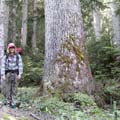
An old-growth tree about 130 cm dbh in the Miner's Creek drainage NE of Glacier Peak, WA. The forest is filled with very large Abies amabilis, Tsuga mertensiana and Tsuga heterophylla and has not experienced fire in at least several hundred years [C.J. Earle, 2003.09.01].
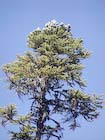
Mature tree with typical cone crop, Washington Pass rest area [C.J. Earle, 2003.08.17].
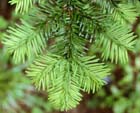
Foliage of a tree on the SW flank of Mt. Rainier, WA. The pale green foliage has emerged within the last few days [C.J. Earle, 1987.07.18].

Cone cut by a Douglas squirrel (Tamiasciurus douglasii), near Tuck Lake, Washington Cascades [C.J. Earle, 2002.09.28].
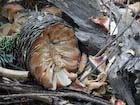
Cone partially consumed by a squirrel, same location [C.J. Earle, 2002].
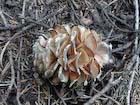
Cone gleaned by a corvid, probably Perisoreus canadensis, same location [C.J. Earle, 2002.09.28].

Seeds with attached wings, same location [C.J. Earle, 2002.09].

Seedling near Hyas Lake, Washington Cascades [C.J. Earle, 2003.08.23].

Bark on a tree, ca. 40 cm diameter, along the North Fork Sauk River trail, northern Washington Cascades [C.J. Earle, 2006.08.06].
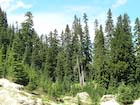
Tsuga mertensiana-Abies amabilis forest below Shark Peak, southern Washington Cascades [C.J. Earle, 2004.07.18].

Two advance regeneration trees growing near the base of a mature Tsuga mertensiana near Kendall Peak, central Washington Cascades [C.J. Earle, 1987.05.17].

Conservation Status

Abies amabilis
Douglas ex J. Forbes 1839
Common names
Pacific silver fir, white fir, red fir, lovely fir, amabilis fir, Cascades fir (Pojar and Mackinnon 1994, Peattie 1950), silver fir, sapin gracieux (Hunt 1993).
Taxonomic notes
Synonymy (Farjon 1998):
- Picea amabilis Douglas ex Loudon 1838;
- Pinus amabilis (Douglas ex Loudon) Parl. in Candolle 1868;
- Abies grandis Hook. 1838 non Lindl. 1833;
- Abies grandis A. Murray bis 1863 non Lindl. 1833;
- A. grandis Franco 1950, non Lindl. 1833.
Description
Trees to 24-46(75) m tall with 60-120 (260) cm dbh; straight, crown spirelike, with age becoming flat topped, cylindric. Bark light grey, smooth but for resin blisters, with age breaking into reddish-grey scaly plates. Branches diverging from trunk at right angles, short, stiff; twigs mostly opposite, darker brown abaxially, light brown adaxially, pubescence tan. Buds small, spherical, brown, globose, 6-9 mm diameter, with violet wax; basal scales short, broad, triangular, densely pubescent, usually not resinous, margins entire, apex sharp-pointed. Needles (0.7)1-2.5(4.0) cm × 1-3 mm, crowded, spreading forwards in 2 rows, overlapping above, nearly covering the branchlet, curved upwards on sun foliage, grooved and dark lustrous green above, somewhat flattened and silvery white with 5-6 stomatal rows on each side of midrib below, apex prominently notched; resin canals small, near margins and abaxial epidermal layer. Male cones at pollination red, becoming reddish yellow. Female cones erect, ovoid-cylindric, resinous, purple-grey then brown, 8-10(18) cm long × 3.5-5(7) cm, sessile, apex round to nipple-shaped; scales ca. 2 × 2 cm, finely pubescent; bracts hidden, purplish, about 1/2 height of scale. Seeds 10-12 × 4 mm, body tan; wing about as long as body, rose to tan; cotyledons 4-7 (Silba 1986, Little 1980, Hunt 1993). See García Esteban et al. (2004) for a detailed characterization of the wood anatomy.
A. amabilis is commonly found with A. lasiocarpa, A. grandis, and A. procera. If cones can be observed, it is easily distinguished from these other species by having considerably larger cones than the first three, and from A. procera by having considerably smaller cones that lack extruded bracts. Lacking cones, it can be distinguished by foliage and by habitat preference. A. bifolia and A. lasiocarpa both have at least a few stomata on the upper surface, and trees in sunny spots have a strong bluish cast, in comparison with A. amabilis. Sunny-site A. procera also has a strong bluish cast. A. lasiocarpa and A. procera are also considerably less shade tolerant than A. amabilis and you will rarely see healthy saplings growing in the dense shade of a continuous Abies canopy; however A. amabilis saplings are common on such sites, sometimes forming the dominant understory species. A. grandis occasionally shows high shade tolerance too, but it is not common within the range of A. amabilis. A. amabilis leaves are straight, linear, spread to both sides of the shoot and are commonly densely laid upon the shoot, with some leaves on shaded foliage appearing to emerge from the dorsal surface of the twig (see photo at right). In comparison, A. procera leaves have a variable "hockey stick" shape, bent near the base. A. grandis leaves, on the other hand, are more strictly pectinate, so that the twig can be easily seen. In habitat, A. amabilis is typically found at higher and wetter elevations than these other species (though it can occur as low as sea level in the western Olympic Peninsula, coastal British Columbia, and southeast Alaska). A. bifolia and A. lasiocarpa also occur at subalpine elevations, but typically on drier sites, and rarely in the company of other wet site conifers such as Tsuga mertensiana and Callitropsis nootkatensis. A. procera, and A. grandis in areas where it grows near A. amabilis, typically occur at lower (montane) elevations, commonly in association with Pseudotsuga menziesii or Tsuga heterophylla.
Distribution and Ecology
US: SE Alaska, W Washington and Oregon, NW California; Canada: W British Columbia. Prefers deep, well-drained soils in cool, moist coastal forests, descending to sea level from Vancouver Island northwards, typically above 1000 m in Oregon and southwards, occurring to timberline (ca. 2300 m). Climate is maritime with long, snowy winters (Pojar and Mackinnon 1994). Fire is rare, typically occurring at intervals of centuries, and in any event A. amabilis is extremely intolerant of fire. See also Thompson et al. (1999). Hardy to Zone 5 (cold hardiness limit between -28.8°C and -23.3°C) (Bannister and Neuner 2001).
Distribution data from USGS (1999).
This species is characteristic of the montane zone of western British Columbia and the subalpine zone in western Washington and Oregon, where it may form mixed or monospecific stands and currently is widely distributed as advance regeneration beneath a canopy of mixed conifer species. Advance regeneration can germinate and grow under an A. amabilis conopy too dense to allow more than 10% ground cover in woody plants and herbs; it is commonly thought that these small trees subsist at least in part on carbon scavenged from root systems of canopy trees, with which their roots are often grafted. Advance regeneration trees less than 2 m tall are often more than 100 years old, and a tree may spend several centuries beneath the canopy before time and gap-phase dynamics allow it to enter the canopy. It is among the most shade-tolerant of all conifers. It has reportedly retained needles for as long as 53 years, a record exceeded only by Welwitschia mirabilis, with needle retention times in excess of 20 years quite common.
Especially in patchy stands or near the alpine timberline, A. amabilis is commonly found with a wide variety of other conifers, including A. lasiocarpa, A. magnifica, A. procera, A. grandis, Picea sitchensis, Pseudotsuga menziesii, Tsuga heterophylla, Tsuga mertensiana, and Callitropsis nootkatensis. The most common understory shrub is Vaccinium alaskaense, with which it forms a distinctive vegetation type widespread in the Cascade and Olympic Mountains.
A. amabilis is subject to parasitism by the dwarf mistletoe Arceuthobium tsugae subsp. amabilae, which is also the primary mistletoe parasite of Tsuga heterophylla (Mathiasen and Daugherty 2007). Other pests known to afflict A. amabilis include the balsam woolly adelgid (Adelges piceae), a wide variety of defoliators, and several bark beetles such as the striped ambrosia beetle (Trypodendron lineatum) and the western balsam bark beetle (Dryocoetes confusus) (Natural Resources Canada 2024).
Remarkable Specimens
Here is the story on big and tall trees:
- Largest tree known to be alive: On 2024.07.18 I measured a tree in Enchanted Valley, Olympic National Park, Washington at 195 cm dbh and 51.98 m tall.
- Largest Oregon tree thought to be alive: Jerry Black reports a tree 131 cm dbh and 42.4 m tall (2013 measurement) in Mt. Hood National Forest, Oregon, along with a slightly larger and much shorter tree in Clatsop County (Black 2019).
- Largest tree ever recorded: a tree on Goodman Creek near Forks, Washington, with a stem volume of 74 m3, dbh 237 cm, height 66.1 meters. This died in the early 2000's.
- Largest tree that really needs to be checked out: the Hades Creek Fir in Olympic National Park, Washington was measured in 1999, with a stem volume of 62 m3, dbh 210 cm, height 66.4 meters. It was not very precisely located; GPS technology was pretty rough in 1999 and it is located in a very remote area. In 2011, American Forests sent a photographer to document and remeasure it, and he couldn't find it. But in the same general area, he found a tree that was measured as 171 cm dbh and 67.67 m tall (American Forests 2020), which became the official champion tree at that time (Robert Van Pelt email 2020.02.24), but has been surpassed by the Enchanted Valley tree.
- Tallest tree ever recorded, might still be alive: Last seen in 1999, when it stood 71.9 meters tall with a dbh of 140 cm, growing on the East Fork of the Humptulips River in Olympic National Forest, Washington (Van Pelt 2000).
The oldest known tree is represented by a measured and crossdated cross-section of a tree that was ">900" years old at the time it was logged (Parish and Antos 2004). There is also a record of 725 years for a specimen found by Ken Lertzman in Cypress Provincial Park, BC (Van Pelt 1996); this tree may still be alive. USFS ecologist Jan Henderson (pers. comm. 1990) reports ring counts of >800 years on stumps of repeatedly suppressed and released trees in Mount Baker-Snoqualmie National Forest, Washington.
Ethnobotany
The pitch was chewed as gum by native peoples, the boughs were preferred for bedding or floor coverings, and the soft, brittle wood was chiefly used as firewood (Pojar and Mackinnon 1994).
It is an important timber species due to its wide distribution and potentially rapid growth; it is primarily a source of pulp. Once (in 2006) it has served as the U.S. Capitol Christmas tree.
The species has been widely used in dendrochronology since about 1980. Applications have included dendroclimatic reconstruction, ecosystem changes in old-growth montane and forest-tundra subalpine forests, dating and effects of volcanic debris flows, forest decline due to volcanic ash deposition, and impacts to tree growth from aluminum smelter emissions.
Observations
Fairly common in the subalpine zone within its range, and easily seen in Olympic, North Cascades and Mount Rainier National Parks (WA). It is more sparsely distributed in Oregon, though common enough in the high country of the Three Sisters Wilderness. In California, only dedicated searching will turn it up: near Hancock Lake (41.,42°N, 123.22°W) in the Marble Mountains, and in the Siskiyou Mountains between Copper Butte and Joe Creek (approx. 41.8°N, 123.2°W), localities at 1,700 to 2,133 meters elevation (Griffin and Critchfield 1972). Also common in British Columbia, but I don't know any outstanding occurrences.
Remarks
This species was discovered and named by David Douglas, Scots botanist. The epithet amabilis means "lovely."
Citations
Black, Jerry. 2019. Oregon Big Tree & Shrub Measurements. Tualatin, OR: Jerry Black.
Forbes, J. 1839. Pinetum Woburnense 125, pl. 44. Available at Google Books (accessed 2012.11.19).
Mathiasen, R. L. and C. M. Daugherty. 2007. Arceuthobium tsugense subsp. amabilae, a new subspecies of hemlock dwarf mistletoe (Viscaceae) from Oregon. Novon 17:222-227.
Natural Resources Canada. 2024. Amabilis fir. https://tidcf.nrcan.gc.ca/en/trees/factsheet/296, accessed 2024.11.20.
Parish, Roberta, and Joseph A. Antos. 2004. Structure and dynamics of an ancient montane forest in coastal British Columbia. Oecologia 141(4):562-576.
See also
Elwes and Henry 1906-1913 at the Biodiversity Heritage Library (Photo). This series of volumes, privately printed, provides some of the most engaging descriptions of conifers ever published. Although they only treat species cultivated in the U.K. and Ireland, and the taxonomy is a bit dated, still these accounts are thorough, treating such topics as species description, range, varieties, exceptionally old or tall specimens, remarkable trees, and cultivation. Despite being over a century old, they are generally accurate, and are illustrated with some remarkable photographs and lithographs.
Farjon, Aljos. 1990. Pinaceae: drawings and descriptions of the genera Abies, Cedrus, Pseudolarix, Keteleeria, Nothotsuga, Tsuga, Cathaya, Pseudotsuga, Larix and Picea. Königstein: Koeltz Scientific Books.
- Provides a detailed account, with illustrations.
FEIS database.
TROPICOS data record.











